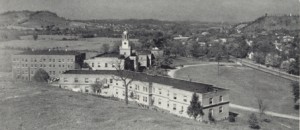40th General Assembly Held During WWII
Perhaps because war is such a common human experience, the Christian tradition frequently uses images and illustrations of battle to illuminate spiritual truths. And although wars come and go, spiritual conflict will be with us until the return of Christ.
This reality captured the attention of the Church of God on September 2, 1945. It was the Sunday of Labor Day weekend. The world’s eyes were fixed on the deck of the USS Missouri as the Japanese military formally surrendered to the Allies bringing to an end the Second World War. With the declaration of a cease-fire two weeks earlier, public places had flooded with celebrating crowds of people. The kiss of an unidentified sailor and nurse in Times Square—two among millions rejoicing that day—came to symbolize the jubilation of a nation and cause that had finally prevailed in victory.
Not all eyes were solely on Japan on September 2, however. For the Church of God there was an even greater war yet to be won. Overseer John C. Jernigan called to order the 40th General Assembly at 9:00 a.m. with a challenge for delegates to fight on uncompromisingly.

Due to wartime travel restrictions, the 40th General Assembly met on the campus of Bible Training School and College in Sevierville, Tennessee.
Because of the nation has been at war, the 40th Assembly was limited in significant respects. Like the very first General Assembly in 1906, it was only two days in length. Wartime rationing had severely restricted travel, so we had to secure a special government permit in order to have the Assembly. With few exceptions, only Bishops were able to attend; and the Assembly convened in our own facilities—the auditorium of the Bible Training School and College in Sevierville, Tennessee.
Despite the wartime trials and suffering, the Church of God was optimistic. According to the general overseer, the previous year’s tithing and giving to ministries such as world missions, the orphanage and the retired ministers’ fund was higher than ever before. Membership gains were up as well. Vep Ellis led the opening song, “When I Get to Heaven,” and not surprisingly, the Assembly gave special honor to “Old Glory” and the freedoms enjoyed in America.
Yet, the end of conflict was not on the minds of delegates that day. Rather their discussion focused on the continuing battle to win the world for Christ. The world war had brought home fresh and compelling images of a world harvest. Numerous speakers reminded hearers about activities of the Church of God around the world, and R.P. Johnson preached about every God-called minister’s need for consecration and the bearing of responsibilities.
Recognizing that victory could not yet be claimed in this battle to win a lost world for Christ, General Overseer Jernigan called the church to arms: “We are no longer a small obscure organization, pushed into back alleys and embarrassed with poverty, but have stepped forward to take our place in the world alongside of other great religious organizations, and if we will fight on uncompromisingly, and push forward the evangelistic work of the Church of God, we will be ready when the Lord returns for His Church.”
————————————
This article was written by Church of God Historian David G. Roebuck, Ph.D., who is director of the Dixon Pentecostal Research Center and assistant professor of the history of Christianity at Lee University. This “Church of God Chronicles” was first published in the February 2002 Church of God Evangel.




